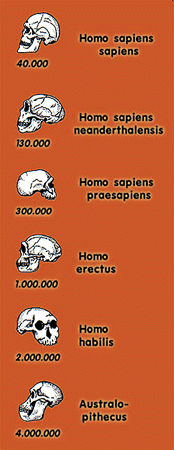

The human species appeared for the first time in Africa at least 3 million
years BP. The earliest human type is the Australopithecus, as human
fossils from southern and eastern Africa indicate.
During the Lower Palaeolithic (2,000,000-100,000 BP) Homo habilis, Homo erectus and Homo sapiens praesapiens lived. Human remains of Homo habilis were found in the Olduvai Gorge (Africa) dating to 2 million years BP. Traces of Homo erectus were found in Africa, in Europe (Homo heidelbergensis, ca. 600,000 BP), in Asia (Chou-Kou-Tien) and in Australia (Java). During the last phases of the Lower Palaeolithic (after 400,000 BP) Homo sapiens praesapiens inhabited Europe, as substantiated by the finds in Swanscombe in Britain, Steinheim in Germany, Petralona and Apidima in Greece.
During the Middle Palaeolithic (100,000-35,000 BP) the evolved type of Homo sapiens praesapiens, the Homo sapiens neanderthalensis dominated in Africa, in Europe and in the Near East. The classic Neanderthal type lived between 80,000-30,000 BP and apparently coexisted in Africa with the early type of Homo sapiens (till 130,000 BP) and in Asia with Homo erectus (till 50,000 BP).
During the Upper Palaeolithic (35,000-10,000 BP) modern man, Homo sapiens sapiens, made his appearance, and can be classified into two types: the Cro-Magnon type (western Europe) with a wide face and short cranium and the Bruenn type (central Europe) with a narrow and long cranium. Traces of Homo sapiens sapiens were found in Africa, Europe and Asia, in areas where former human types had inhabited but also in America and Oceania which must have been inhabited for the first time in 35,000 BP.

Until recently it was believed that modern man (Homo sapiens sapiens) was a direct descendant of Homo sapiens neanderthalensis. However, comparative studies of German and American scientists who examined the DNA in bones of Neanderthal man and modern humans and cloned the DNA of the bones from the Neander valley, excluded any genetic relation between the two species. According to the new evidence, a human influx of Homo sapiens migrated 100,000 years ago from Africa and coexisted for some time with the Neanderthals who gradually became extinct. At this point it is worth noting that human types like the Neanderthal could survive only in cold climates while the early Homo sapiens sapiens, the Cro-Magnon type, could only live under warmer climatic conditions. Thus, according to climatic changes which occurred during the end of Pleistocene as well as human remains, all types of modern man originated from a relatively recent human group.





